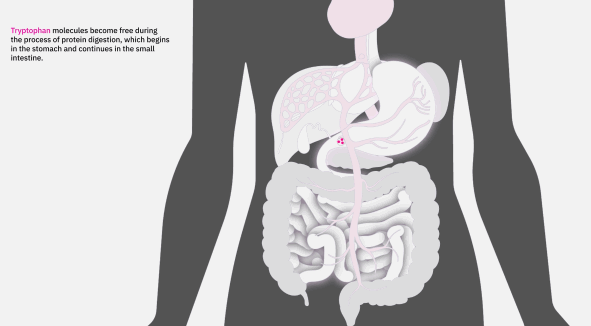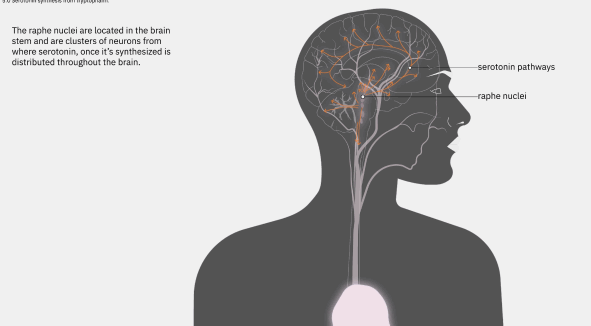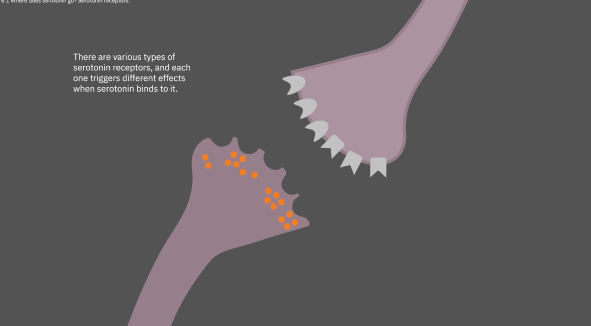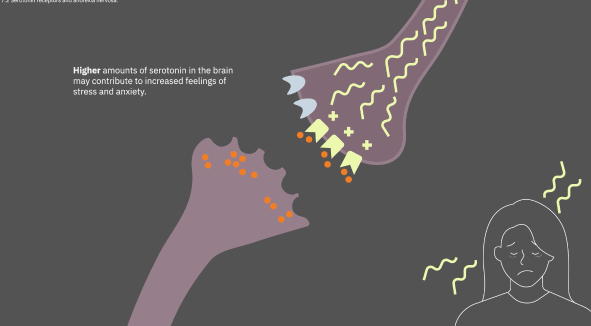Understanding Anorexia: Making Medical Research Accessible
An interactive scrollytelling explainer translating complex neuroscience into visual narrative
Research & Design, 2023-2025
By Kimberly Blacutt
(Research Assistant for Stacie Rohrbach at Carnegie Mellon University)

How does anorexia affect the brain and the body? I spent two years researching this question, analyzing existing eating disorder resources, and developing an interactive visual explanation of the biological mechanisms underlying anorexia nervosa.
From Tryptophan to Serotonin
I focused on explaining the tryptophan-serotonin pathway - how an essential amino acid from food becomes a neurotransmitter that affects mood, anxiety, and eating behavior. This biological process is central to understanding anorexia, but it's typically buried in dense medical literature.
My goal: Create a visual narrative that follows tryptophan's journey through the body, making complex neuroscience understandable without oversimplifying.
The Journey Begins
Tryptophan is an essential amino acid, and we need to get it from our diet.
Digestion & Absorption
Tryptophan molecules become free during the process of protein digestion, which begins in the stomach and continues in the small intestine.
Crossing the Blood-Brain Barrier
The colorful dots represent different types of amino acids, including tryptophan, that are transported across the blood brain barrier.
The Raphe Nuclei
The raphe nuclei are located in the brain stem and are clusters of neurons from which serotonin pathways are distributed throughout the brain.
Serotonin Receptors
There are various types of serotonin receptors, and each receptor type has a unique role when serotonin binds to it.
The Connection to Anxiety
Higher amounts of serotonin in the brain may contribute to increased feelings of stress and anxiety.
Why This Research and Storytelling Matters
Eating disorders have the highest mortality rate of any mental illness. Yet much of the public conversation focuses on behavior and willpower rather than the underlying biology. By making neuroscience accessible, this project helps:
People with EDs understand what's happening in their bodies
Support networks grasp the biological reality of the illness
General audiences move beyond stigmatizing misconceptions
This project demonstrates how graphics journalism can translate expert knowledge into forms that empower broader audiences.
Tools: Adobe Illustrator, After Effects, Miro, Shorthand (for scroll interactions)
Research Methods: Content analysis, literature review, narrative development, user-centered design
Duration: 2023-2025 (ongoing)
My goal: Create a visual narrative that follows tryptophan's journey through the body, making complex neuroscience understandable without oversimplifying.
The Research:
Finding the Gaps
In Fall 2023, I worked as a research assistant for Professor Stacie Rohrbach, analyzing eating disorder resources on social media, specifically Instagram. I focused on Instagram because research shows that social media platforms, especially image-centric ones like Instagram, are significantly associated with eating disorder risk, especially among adolescent girls and young women who spend considerable time on these platforms. If young people are already spending time on Instagram, understanding what eating disorder content exists there and what's missing becomes crucial for intervention.
I reviewed 32 profiles, developing evaluation frameworks to assess tone, content quality, intended audience, and content categories.
What I discovered:
Most ED content was anecdotal and conversational rather than fact-based
Very few resources explained the biological mechanisms of eating disorders
Healthcare professionals' resources weren't reaching general audiences
There was an opportunity to translate medical research into accessible visual formats
Key insight: People recovering from eating disorders and their support networks needed better access to the scientific understanding of what's happening in the body and brain.
This initial exploration led me to ask: Could we take an academic or medical journal or paper - ones healthcare professionals that treat people with eating disorders might read and communicate that in a more accessible way?
As a solution, I proposed developing scrollytelling narratives to make this research accessible. The story you see above emerged from this research. Today I am working with an expanded research team including: Stacie Rohrbach (PI), Kimberly Blacutt, Sage Rohrbach, Elijah Benzon. We are currently working on creating a web article that empowers readers by providing accessible, research-backed information. I want to make sure it's both scientifically accurate and emotionally supportive.
Click here for a Shorthand story preview I illustrated and animated myself.





